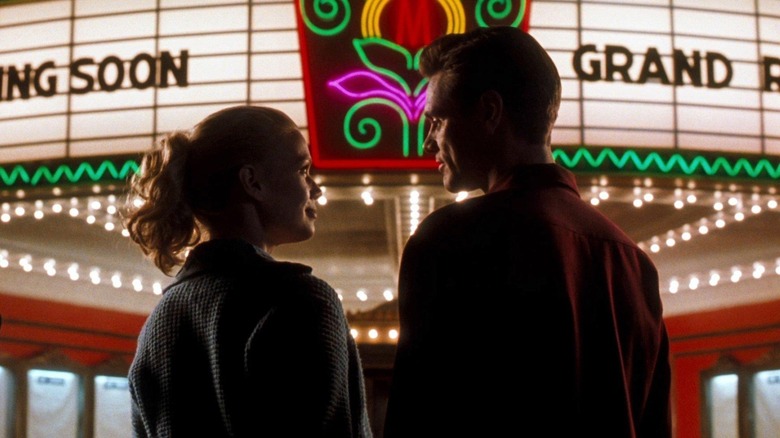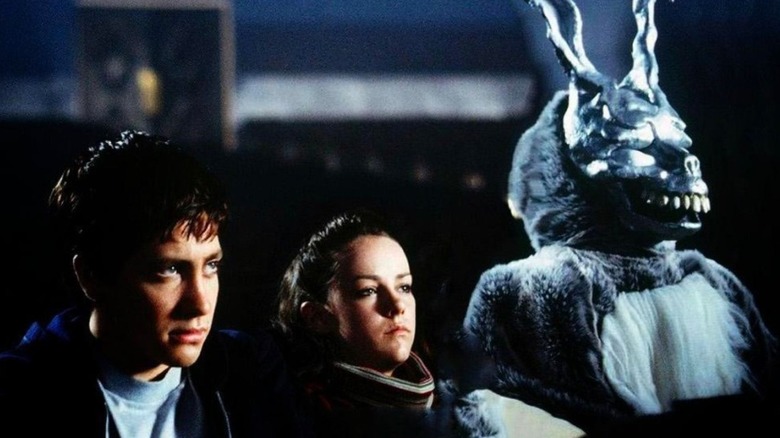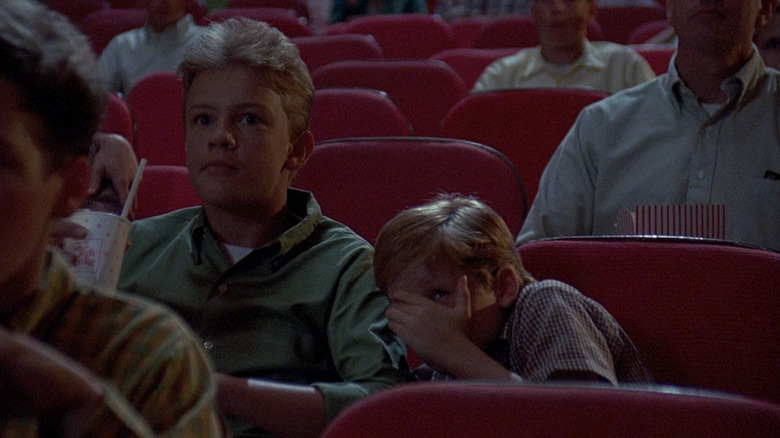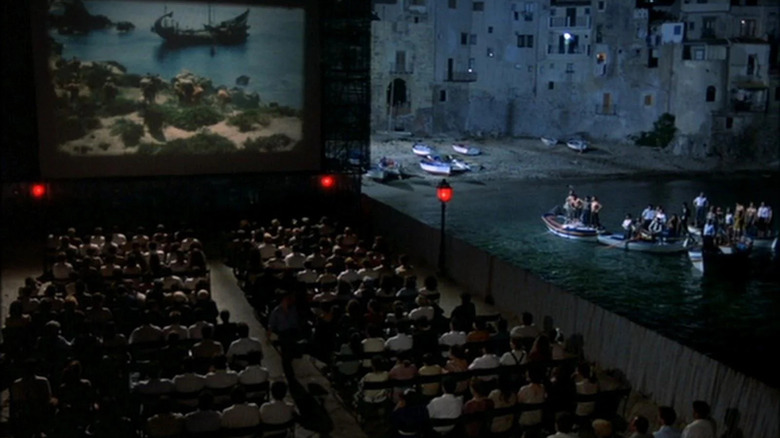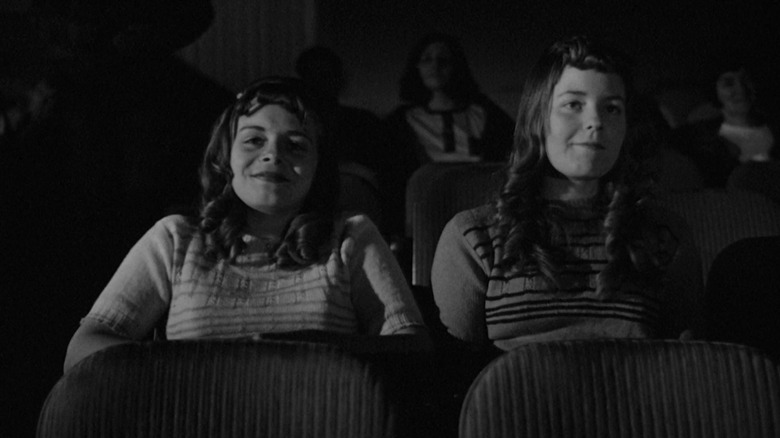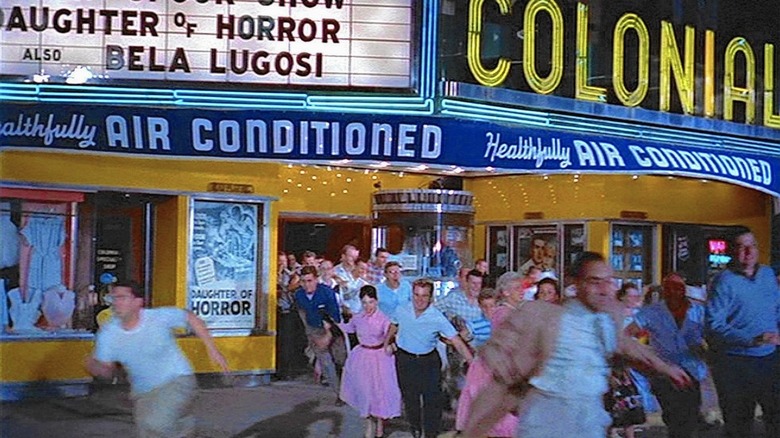What Hollywood's Past Two Years Means For The Future Of Movie Theaters
May 22, 2022 was the last day The Landmark theater — located on the corner of Westwood and Pico Blvd. in Los Angeles, CA — was open for business. The 12-screen theater opened in 2007 as an adjunct of the then-still-open Westside Pavilion, an indoor shopping mall that had itself been in operation since 1985. The Landmark was connected to the shopping plaza by a bridge that stretched over Westwood, and shared retail space with a three-story Barnes & Noble (accessed through the theater's lobby) and an upscale tavern on the ground floor.
As the caprices of capitalism dictate, however, landlords eventually started dismantling pieces of the mall/theater setup, eventually selling the whole of the Pavilion to Google (a massive office complex is currently being constructed in its space), shuttering the tavern, and booting out Barnes & Noble for a furniture store and then, eventually, a vacant storefront. By itself, the Landmark — part of Landmark Theaters, a company that was acquired by the Cohen Media Group in 2018 — continued to operate for several years, offering premieres, Q&A's with filmmakers, a cocktail bar, upscale eats, and the occasional 70mm projection. The Landmark's 12 screens were deliberately devoted to a mix of independent, international, and mainstream commercial fare. The theater closed permanently on Monday. Landmark now only has two screens on L.A.'s Westside: The Nuart, and The Westwood.
That which survives
The Landmark is but the latest of theatrical closings in a marketplace that has become increasingly hostile to movie theaters. Many financial articles have been written discussing the negative impact of COVID-19 on the movie business, and anyone in a theater saturated town likely saw the closure of many local movie houses. The fact remains that there are fewer screens operating in the United States than there were only two years ago, and despite enormous box office from a "Godzilla," "Batman," or "Doctor Strange," theaters have been suffering overall. And, contrary to what Nicole Kidman has told us, that kind of heartbreak doesn't feel good.
In the future, only smaller independent theaters will survive. The rest will be owned by Netflix, Disney, Amazon, and other studios. That's legal now.
Of course, movie theaters have been dealt serious blows in the past. The 1950s saw a massive closure of movie theaters, largely due to the popularization of television sets, but also the movement of many American families into the suburbs, far away from "destination" downtown movie houses. Importantly, January 1, 1950 was the date the 1948 Paramount Decree took effect, effectively banning movie studios from owning their own theaters. Prior to the decree, studios were permitted to produce movies and as well as run the theaters that exhibited them, causing a self-dealing, vertical integration system that was the industry norm for decades. Paramount, MGM, Fox, Warner Bros., and RKO — the "big five" — owned about 65% of the nation's theaters. This system was convenient for the studios, but intentionally muscled out any competition from small studios who wanted to be shown in theaters.
History: The end of Hollywood's Golden Age
The short, short version: After the Paramount Decree, many theaters were sold off or simply closed down. The "Golden Age" of Hollywood was at an end. People were watching more TV, and uptight citizens groups began targeting movies for their marketing of "Unamerican values" to people, souring the cinema for many. A modest cottage industry of grindhouses and drive-ins began to grow in its place, and independent movie theaters finally had a chance. It wouldn't be for a decade that movie theaters would start to breathe a healthy life again, although in a completely different form — and considerably less profitable — from the "movie palace" era of the 1940s.
Fast forward to the 2010s: A similar blow was dealt to theaters thanks to the advent of streaming technology. People could still watch movies at home as they could with TV, then later VHS and DVDs, but now it was a widget wired directly into their TV sets, allowing them (presumably) access to a greater library of titles (though inconsistent streaming libraries have many longing for the days of a well-stocked video rental store). A poll conducted in 2020 revealed, for the first time, that audiences preferred seeing a movie at home than in theaters. This, of course, was due to the lockdowns required by COVID-19, but it finally cemented something that had been happening for the better part of the decade. Release windows became smaller and smaller. Theaters were increasingly moribund.
What the future holds
The COVID-related closure of theaters was exacerbated by a New York federal judge's sudden overturning of the Paramount Decrees in August of 2020. Thanks to the vertical integration of studios with their own streaming services (Disney+, Paramount+, etc.), competition was being specifically left out, allowing bigger shows to have full control over their content exclusively. While modern streaming vertical integration did lead to several high profile legal cases (the "Bones" case being one of the more prominent), it was clear vertically integrated streaming was the way of entertainment moving forward. Studios would control their own content.
What does this all mean for theaters? It seems that the removal of the Paramount Decrees, and the open embracing of vertical integration, spells out a clear future for the industry: The richest of the studios, already commanding their own streaming services, are in a position to open their own theaters.
The future of cinema will — perhaps slowly, perhaps quickly — come to see a landscape commanded by enormous movie palaces that will only show one studio's films. Disney and Amazon already own theaters in Los Angeles (Disney owns the El Capitan on Hollywood Blvd., Netflix owns the Egyptian down the street) and are now in a position to offer their own product exclusively in those venues. The El Capitan already offers amusement park-like opening days for some of Disney's bigger blockbusters, offering a meet-and-greet with the characters (actors in costumes), a merch store in the lobby, and organ music as an intro. The El Capitan has made a business of turning every screening into an all-day, celebratory affair.
The big and the small, and nothing in-between
I suspect, as blockbusters continue to balloon in budget and size, all commercial films will eventually be presented in such a fashion. Disney-owned theaters will show the latest Marvel blockbuster or "Star Wars" spectacular more as an experience than a mere film. I also suspect ticket prices will increase to match the enormity of said experience. It's likely that, by the time "Avatar 3" hits theaters, you will pay $250 to see it in ultra-premium high-tech projection, sit in giant seats, and enjoy an exhibit of the making of the film after. James Cameron may come by for a Q&A on opening day. The film will easily run over 200 minutes. It will compete with Matt Reeves' "The Third Batman" down the street at The Warner Theater. That film will run 250 minutes.
The only other types of cinemas that will survive will be the smaller indie houses that have low overhead. There will always be a market for the outré, and indie theaters will be able to provide a modest experience at a lower price point. Thanks to advances in digital projection technology, some indie houses have eliminated their projection booths altogether, mounting smaller digital projectors — operated by remote with an iPad — on the theater's rear wall. Loading films directly — and eventually by remote broadcast from the distributors — will eliminate a lot of issues with presentation and distribution.
Goodbye, multiplex
The era of the 1990s multiplex is coming to an end. The glory days of taking in mid-budget studio fare multiple times in a week at your neighborhood's seven-plex are essentially over. Multiplexes are already going the way of shopping malls. Yes, several will hang on, and one may be able to visit a multiplex on the outskirts of larger cities. But outsize, airport-looking 12-screen theaters are, as we have seen, closing by the score. Blockbusters are making more money than mid-budget fare, which are currently going to straight-to-streaming.
A few weeks ago, a Barry Levinson film called "The Survivor" was put on HBO Max. It was a high-end prestige release, a biography of Harry Haft, a Jewish professional boxer who survived life in Nazi concentration camps by fighting other prisoners for his captors' amusement. It stars Ben Foster, Danny DeVito, Vicky Krieps, and John Leguizamo. In the Before Times, a film like "The Survivor" would have been released in theaters during Oscar season and would have been in the conversation for major awards. In 2022, it is released on HBO Max without much fanfare. This is the world we live in. The mid-budget, adult focused, prestige fare that was once the bread and butter of the multiplex is now merely two more hours of online "content." The big theatrical money is now in Multiverses of Madness, Top Guns, and big-budget movies that come pre-sold with a pedigree and maybe some juicy IP.
Theaters will survive, of course; few mediums ever truly die out. But times are in the midst of changing, and we're moving into an era where only the smallest and the biggest will be in play. Start saving for the amusement park movies of the future, as they will be expensive. While you save, you can watch the more interesting art on a budget in your neighborhood. For everything else, you'll stay home.
